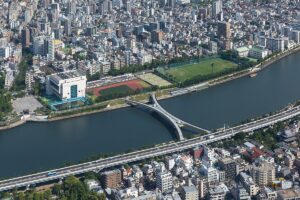Gokayama Gassho-style Village (Nanto City, Toyama Prefecture) — Overview (History, Features, and Attractions)
Gokayama is a group of Gassho-style villages in Nanto City, Toyama Prefecture, which, together with Shirakawa-go (Gifu Prefecture), were registered as a UNESCO World Heritage Site in 1995 as the "Gassho-style Villages of Shirakawa-go and Gokayama." The most representative villages are Ainokura and Suganuma, where traditional farmhouses (Gassho-style houses) with steeply sloping thatched roofs have been preserved, and which continue to convey the culture of agriculture, forestry, and sericulture that has continued since the Edo period.
The name "Gassho-zukuri" comes from the likening of a gabled roof to the shape of palms clasped together (gassho), and is characterized by a steeply sloped thatched roof to withstand heavy snow. The attic was used to store sericulture and agricultural equipment, and the house itself tells the history of life and the community. The beautiful scenery of the thatched roof and the changing nature of the seasons (snow, fresh greenery, autumn leaves) are attractive, and you can also stay at a guesthouse and experience the quiet of the night and the warmth of the hearth.
Highlights
- Ainokura Village: This area is densely packed with traditional houses, and the entire village retains its traditional appearance. The view from the observation deck overlooking the village is a great photo spot.
- Suganuma Village: A quiet village where rice fields and houses coexist in harmony. The scenery changes with the seasons, making it a great place for a stroll.
- A Gassho-style house and museum open to the public: There is a house that displays the lifestyle and sericulture equipment of the time, and you can learn about the lifestyle and culture by touring the interior (please be mindful of etiquette when entering and viewing the building).
- Washi-making experience (Washi Village, etc.): There is a facility where you can experience making Gokayama washi paper (handmade washi paper), which is perfect for making souvenirs.
- Walking and hiking in Satoyama: You can enjoy nature and traditional scenery on the footpaths and Satoyama routes around the village. Panoramic shots from the observation spots are especially beautiful in the early morning and evening.
- Minshuku (traditional Japanese-style house): You can stay in a Gassho-style house, experience cooking over an open hearth, and experience local life. We also recommend enjoying the quiet of the night and stargazing.
Access (nearest station, transportation, etc.)
As Gokayama is located in a mountainous area, public transportation is limited. Please be sure to check the routes and timetables before visiting.
- car: Approximately 1 to 1.5 hours from Kanazawa city, and 1 to 1.5 hours from Toyama Station (depending on road conditions and route). Parking is available in each village, but may be full during peak season.
- Public transportation (bus): The main way to get there is by bus. From Kanazawa, Toyama, or Takaoka, you can take the Toyama Chiho Railway or bus (Kaetsuno Bus, Nanto City Community Bus, etc.) to Ainokura and Suganuma. As there are only a few buses, please check the times of the first and last buses in advance.
- Sightseeing Tours: Many people visit the area on day trip bus tours departing from Kanazawa or Takayama, which are convenient as they include transportation and commentary.
- RecommendationIf you are using public transportation, plan ahead. If you are driving, be sure to take precautions against snow in winter (such as snow tires or chains).
Estimated stay (estimated time required)
- A quick tour of either Ainokura or Suganuma: 30 minutes to 1 hour
- Village tour (including museum admission and washi paper making experience): 1.5 to 3 hours
- Visiting both Ainokura and Suganuma: 2-4 hours (including travel time)
- If you want to stay in a traditional Japanese house and have a relaxing experience: 1 night (including dinner and a morning stroll will give you a full experience)
Nearby spots
- Shirakawa-go (Gifu Prefecture): A famous Gassho-style village. It is often visited by car or as part of a tour (please check transportation options).
- Gokayama Washi Village: You can experience making washi paper, see exhibits, and purchase souvenirs (reservations may be required for the experience).
- Tourist spots around Nanto City:Wood carvings and townscapes of Johana and Inami, Tonami Tulip Park (spring), etc.
- Tateyama Kurobe Alpine Route (Toyama side): If you match the season and route, you can also combine it with sightseeing in Mt. Tateyama.
Things to be aware of (crowds, manners, seasonal precautions, etc.)
- Traffic and congestionParking lots and buses will be crowded during tourist season (autumn foliage season, Golden Week, winter holidays, etc.). Public transportation is infrequent, so please plan your trip accordingly, taking into account the time of your return trip.
- Entrance etiquetteSome Gassho houses are still in use and some are privately owned. Please follow the signs indicating no entry or photography, remove your shoes in areas where shoes are strictly prohibited, and only take photos or view the buildings in the designated areas.
- Quietness and consideration for local residents: This is a residential area. Please be considerate of the local community by not shouting and taking your trash with you.
- Winter precautions: Because this area experiences heavy snowfall, studless tires and chains are essential for cars. Please check in advance for information on frozen roads and road closures. While the winter scenery is beautiful, facilities and activities may be limited.
- Clothing and equipment:Because it is in the mountains, it can get chilly in the mornings and evenings. It is a good idea to wear comfortable walking shoes and bring rain gear and cold weather gear.
To ensure a smooth trip, please check the official tourist website, Nanto City's information page, and bus company timetables before your visit. Enjoy a quiet and relaxing stay, respecting the charm of the Gassho-style architecture.



